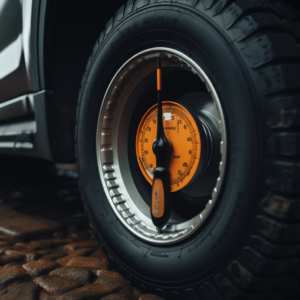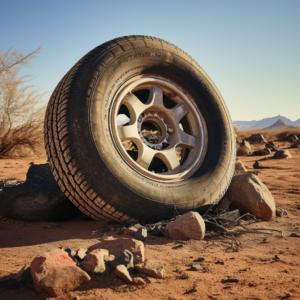Why Do Spare Tires Have Higher PSI?
Intro-
Why do spare tires have higher PSI? – It’s a question that often pops up when we encounter a flat tire on the road. In this article, we will delve into the reasons behind this phenomenon, exploring the safety and engineering aspects that make spare tires essential in emergencies.

What is PSI and Why It Matters?
PSI stands for “Pounds per Square Inch,” and it is a unit of measurement used to quantify tire pressure. Proper tire pressure is crucial for maintaining the overall health and performance of your vehicle. Underinflated tires can lead to reduced fuel efficiency, uneven tread wear, and compromised handling. On the other hand, overinflated tires can result in a harsher ride and increased risk of a blowout. Understanding PSI and its impact on tire performance is essential to comprehend why spare tires require higher pressure.
Understanding Spare Tires
Spare tires, also known as “donuts” or “space-savers,” are compact, temporary replacements for flat tires. Unlike regular tires, spare tires are designed for short-term use until you can reach a repair shop. They are narrower and lighter, making them easier to store in your vehicle’s trunk or undercarriage. However, this convenience comes with certain trade-offs, and understanding the unique characteristics of spare tires is essential.

The Purpose of Spare Tires
Spare tires serve a crucial purpose in providing a temporary solution when you experience a flat tire during your journey. They are not designed for prolonged use or high-speed driving. Instead, they offer enough stability and support to get you to the nearest repair facility safely. Understanding their temporary nature helps explain why spare tires have higher PSI compared to regular tires.
The Importance of Higher PSI
The increased pressure helps the spare tire maintain its shape and stability under the weight of the vehicle. It prevents excessive flexing that could lead to premature failure. Manufacturers deliberately choose a higher PSI for spare tires to ensure their functionality during emergencies. This deliberate choice offers the required rigidity and load-bearing capacity for the limited distance they are meant to cover.
Ensuring Stability and Performance

Higher PSI in spare tires not only enhances stability but also improves their performance during emergency manoeuvres. Spare tires are often narrower than regular tires. The increased pressure allows for better cornering and handling on short drives. Keep in mind that spare tires are not engineered for long journeys or high-speed driving, so it’s crucial to exercise caution when using them.
How are spare tires different from Regular Tires?
Tire manufacturers engineer regular tires for prolonged use, aiming to deliver a smooth and comfortable ride. They optimize these tires for performance, durability, and fuel efficiency. In contrast, they construct spare tires for temporary purposes, prioritizing compactness and convenience over long-term performance. The higher PSI in spare tires helps compensate for their limited design and ensures they can fulfil their purpose when needed.
Choosing the Right Spare Tire
Selecting the right spare tire is crucial for your safety and peace of mind. When buying a spare tire, make sure it matches the size and specifications recommended by your vehicle’s manufacturer. Additionally, consider investing in a full-size spare tire if your vehicle allows for it. While full-size spares take up more space, they provide better performance and can be used for longer distances.

Maintaining Your Spare Tire
Just like regular tires, spare tires require proper maintenance. Regularly check the tire pressure and ensure it meets the recommended PSI level. Inspect the spare tire for any signs of damage, such as cracks or punctures, and replace it if necessary. Remember, a well-maintained spare tire is your best companion in case of emergencies.
Testing and Inspection of spare tires-
Periodically testing and inspecting your spare tire is essential to ensure its functionality when you need it most. As spare tires are often stored for extended periods without use, they may lose pressure over time. Check the tire pressure and condition at least once a month, and remember to include it in your routine tire rotation schedule.

Safety Measures and Recommendations
Using a spare tire should be done with caution and adherence to safety guidelines. Avoid exceeding the recommended speed limit while driving on a spare tire, and never overload your vehicle. As soon as possible, reach a repair facility to assess the damaged tire and make appropriate repairs or replacements. Remember, spare tires are meant to be a temporary solution, not a long-term replacement for regular tires.
Final Takeaway-
In conclusion, spare tires have higher PSI to ensure they can withstand the weight of your vehicle and provide stability during short drives to the nearest repair facility. Understanding the unique characteristics of spare tires helps us appreciate their purpose and use them effectively during emergencies. Remember to choose the right spare tire, maintain it properly, and test it periodically to ensure your safety on the road.
FAQs
- Why do spare tires have higher PSI than regular tires?
-Spare tires have higher PSI to provide the necessary stability and load-bearing capacity for short drives during emergencies.
- Can I use a spare tire for long-distance driving?
-No, spare tires are not designed for long-distance driving. They are intended for temporary use until you can reach a repair facility.
- What is the difference between a full-size spare tire and a space-saver spare tire?
– A full-size spare tire is the same size as your regular tires and offers better performance but takes up more space. A space-saver spare tire is narrower and lighter, providing temporary use and greater trunk space.
- How often should I check the spare tire’s pressure?
– It is recommended to check the spare tire’s pressure at least once a month and before long trips.
- Can I drive at normal speeds on a spare tire?
-While driving on a spare tire, it is best to maintain a safe and cautious speed, as spare tires are not designed for high-speed driving.
